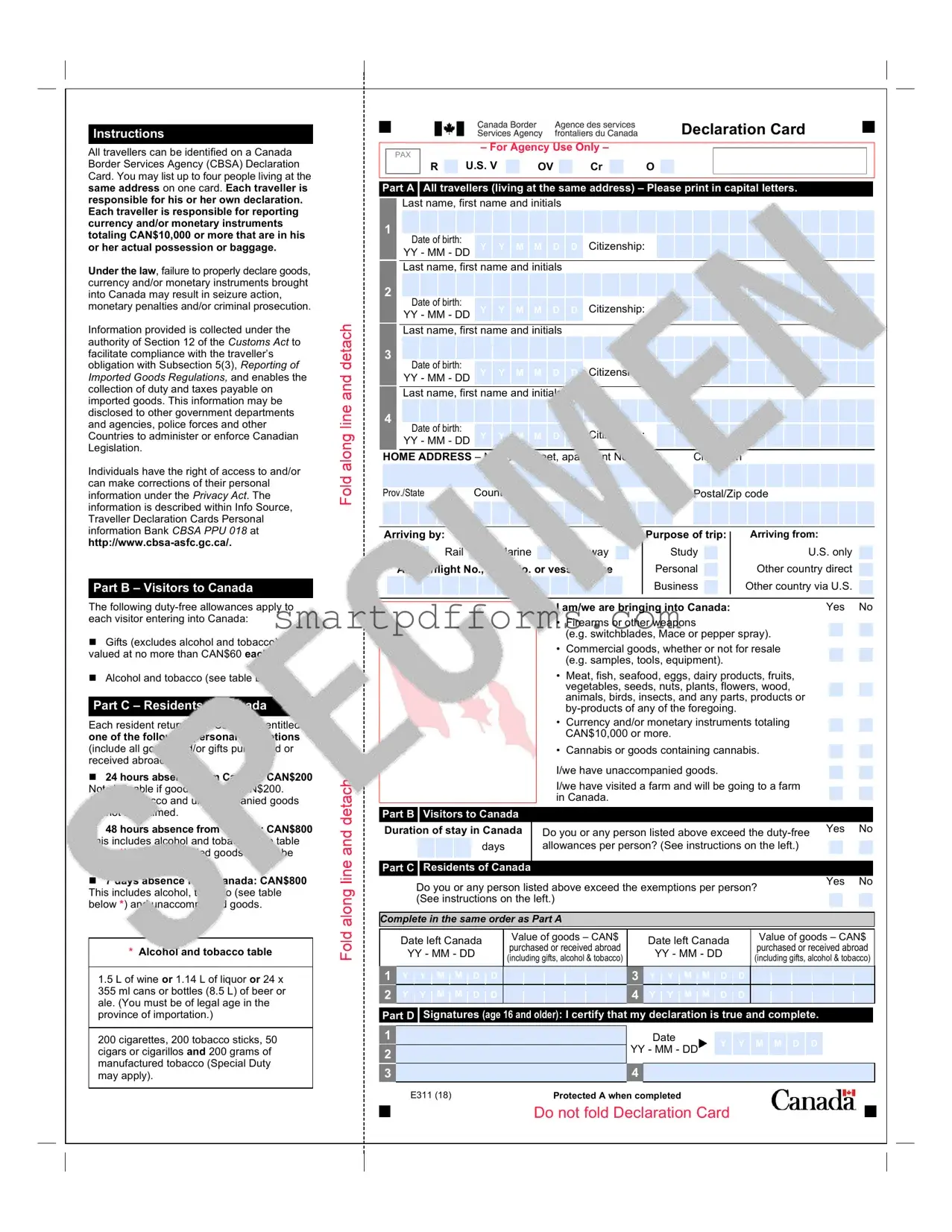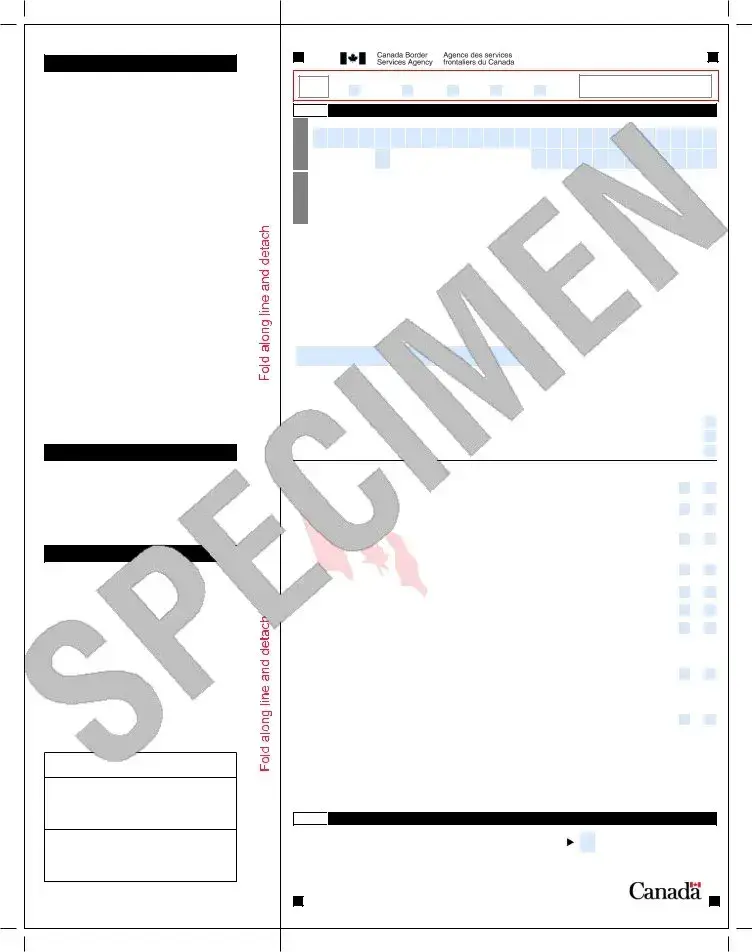Instructions
All travellers can be identified on a Canada Border Services Agency (CBSA) Declaration Card. You may list up to four people living at the same address on one card. Each traveller is responsible for his or her own declaration. Each traveller is responsible for reporting currency and/or monetary instruments totaling CAN$10,000 or more that are in his or her actual possession or baggage.
Under the law, failure to properly declare goods, currency and/or monetary instruments brought into Canada may result in seizure action, monetary penalties and/or criminal prosecution.
Information provided is collected under the authority of Section 12 of the Customs Act to facilitate compliance with the traveller’s obligation with Subsection 5(3), Reporting of Imported Goods Regulations, and enables the collection of duty and taxes payable on imported goods. This information may be disclosed to other government departments and agencies, police forces and other Countries to administer or enforce Canadian Legislation.
Individuals have the right of access to and/or can make corrections of their personal information under the Privacy Act. The information is described within Info Source, Traveller Declaration Cards Personal information Bank CBSA PPU 018 at http://www.cbsa-asfc.gc.ca/.
Part B – Visitors to Canada
The following duty-free allowances apply to each visitor entering into Canada:
Gifts (excludes alcohol and tobacco) valued at no more than CAN$60 each.
Alcohol and tobacco (see table below *).
Part C – Residents of Canada
Each resident returning to Canada is entitled to one of the following personal exemptions (include all goods and/or gifts purchased or received abroad):
24 hours absence from Canada: CAN$200 Not claimable if goods exceed CAN$200. Alcohol, tobacco and unaccompanied goods cannot be claimed.
48 hours absence from Canada: CAN$800 This includes alcohol and tobacco (see table below *). Unaccompanied goods cannot be claimed.
7 days absence from Canada: CAN$800 This includes alcohol, tobacco (see table below *) and unaccompanied goods.
* Alcohol and tobacco table
1.5L of wine or 1.14 L of liquor or 24 x 355 ml cans or bottles (8.5 L) of beer or ale. (You must be of legal age in the province of importation.)
200 cigarettes, 200 tobacco sticks, 50 cigars or cigarillos and 200 grams of manufactured tobacco (Special Duty may apply).
Declaration Card
– For Agency Use Only –
PAX
Part A 
 All travellers (living at the same address) – Please print in capital letters.
All travellers (living at the same address) – Please print in capital letters.
Last name, first name and initials
1
Date of birth: |
Y |
Y |
M |
M |
D |
D |
Citizenship: |
YY - MM - DD |
|
|
Last name, first name and initials |
|
2 |
|
|
Date of birth: |
|
|
|
|
|
|
|
|
|
|
|
|
|
|
|
|
|
|
|
Y |
Y |
M |
M |
|
D |
D |
Citizenship: |
|
|
|
|
|
|
YY - MM - DD |
|
|
|
|
|
|
|
|
|
|
|
|
|
|
|
|
|
|
|
Last name, first name and initials |
|
|
|
|
|
|
|
|
|
3 |
|
|
Date of birth: |
|
|
|
|
|
|
|
|
|
|
|
|
|
|
|
|
|
|
|
Y |
Y |
M |
M |
|
D |
D |
Citizenship: |
|
|
|
|
|
|
YY - MM - DD |
|
|
|
|
|
|
|
|
|
|
|
|
|
|
|
|
|
|
|
|
|
|
|
|
|
|
|
|
|
Last name, first name and initials |
|
|
|
|
|
|
|
|
|
4 |
|
|
Date of birth: |
|
|
|
|
|
|
|
|
|
|
|
|
|
|
|
|
|
|
|
Y |
Y |
M |
M |
|
D |
D |
Citizenship: |
|
|
|
|
|
|
YY - MM - DD |
|
|
|
|
|
|
|
|
|
|
|
|
|
HOME ADDRESS – Number, street, apartment No. |
City/Town |
|
Prov./State |
Country |
|
|
|
|
|
Postal/Zip code |
|
|
|
|
|
|
|
|
|
|
|
|
|
|
|
|
|
Arriving by: |
|
|
|
|
|
|
|
|
|
|
|
|
Purpose of trip: |
|
|
Arriving from: |
|
|
|
|
|
|
|
|
|
|
|
|
|
Air |
|
|
Rail |
|
Marine |
|
|
Highway |
|
|
|
Study |
|
|
U.S. only |
|
|
|
|
|
|
|
|
|
Airline/flight No., train No. or vessel name |
|
Personal |
|
|
Other country direct |
|
|
|
|
|
|
|
|
|
|
|
|
|
|
|
|
|
|
Business |
|
|
Other country via U.S. |
|
|
|
|
|
|
|
I am/we are bringing into Canada: |
|
Yes |
No |
|
|
|
|
|
|
|
• |
Firearms or other weapons |
|
|
|
|
|
|
|
|
|
|
|
|
(e.g. switchblades, Mace or pepper spray). |
|
|
|
|
|
|
|
|
|
|
• |
Commercial goods, whether or not for resale |
|
|
|
|
|
|
|
|
|
|
|
(e.g. samples, tools, equipment). |
|
|
|
|
|
|
|
|
|
|
|
• |
Meat, fish, seafood, eggs, dairy products, fruits, |
|
|
|
|
|
|
|
|
|
|
|
vegetables, seeds, nuts, plants, flowers, wood, |
|
|
|
|
|
|
|
|
|
|
|
animals, birds, insects, and any parts, products or |
|
|
|
|
|
|
|
|
|
|
|
by-products of any of the foregoing. |
|
|
|
|
|
|
|
|
|
|
|
• |
Currency and/or monetary instruments totaling |
|
|
|
|
|
|
|
|
|
|
|
CAN$10,000 or more. |
|
|
|
|
|
|
|
|
|
|
|
• |
Cannabis or goods containing cannabis. |
|
|
|
|
|
|
|
|
|
|
I/we have unaccompanied goods. |
|
|
|
|
|
|
|
|
|
|
|
I/we have visited a farm and will be going to a farm |
|
|
|
|
|
|
|
|
|
|
in Canada. |
|
|
|
|
|
|
|
|
|
|
|
|
|
|
|
|
|
|
|
|
|
Part B |
|
Visitors to Canada |
|
|
|
|
|
|
|
|
|
Duration of stay in Canada |
|
Do you or any person listed above exceed the duty-free Yes |
No |
|
|
|
days |
|
|
allowances per person? (See instructions on the left.) |
|
|
|
|
|
|
|
|
|
|
|
|
|
|
|
|
|
|
Part C |
|
Residents of Canada |
|
|
|
|
|
|
|
|
|
|
Do you or any person listed above exceed the exemptions per person? |
Yes |
No |
|
|
|
|
|
|
(See instructions on the left.) |
|
|
|
|
|
|
|
|
|
|
|
|
|
|
|
|
|
|
Complete in the same order as Part A |
|
|
|
|
|
|
|
|
|
|
|
|
|
|
|
|
|
|
|
|
|
|
|
Date left Canada |
Value of goods – CAN$ |
|
Date left Canada |
Value of goods – CAN$ |
|
purchased or received abroad |
|
purchased or received abroad |
|
YY - MM - DD |
|
YY - MM - DD |
|
(including gifts, alcohol & tobacco) |
|
(including gifts, alcohol & tobacco) |
|
|
|
|
|
|
|
|
|
|
|
|
|
|
|
|
|
|
|
|
|
|
1 |
Y Y M M D D |
|
|
|
|
|
3 |
Y Y M M D D |
|
|
|
|
2 |
Y Y M M D D |
|
|
|
|
|
4 |
Y Y M M D D |
|
|
|
|
Part D 
 Signatures (age 16 and older): I certify that my declaration is true and complete.
Signatures (age 16 and older): I certify that my declaration is true and complete.
1 |
|
|
|
Date |
|
|
|
|
|
|
|
Y |
Y |
M |
M |
D |
D |
|
2 |
|
|
YY - MM - DD |
|
|
|
|
|
|
|
|
|
|
|
|
|
|
|
|
|
|
|
|
|
3 |
|
|
4 |
|
|
|
|
|
|
|
|
|
E311 (18) |
Protected A when completed |
|
|
|
|
|
|
|



 All travellers (living at the same address) – Please print in capital letters.
All travellers (living at the same address) – Please print in capital letters.
 Signatures (age 16 and older): I certify that my declaration is true and complete.
Signatures (age 16 and older): I certify that my declaration is true and complete.